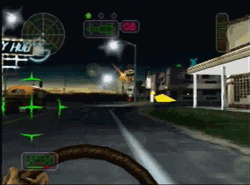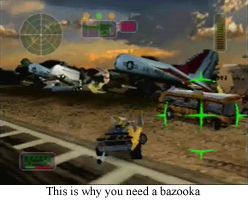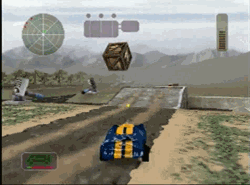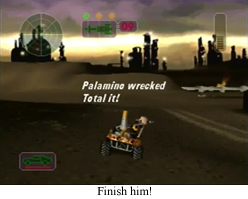 Fighting games are the closest experiences we have to “standard” cinematic experiences. Your average “action”-based affair features a hero, hero’s best friend, and hero’s inevitable love interest versus the forces of bad guy and bad guy’s second. Toss in a couple of comic relief characters (works for either side), an inescapably doomed mentor, and maybe the romantic lead’s chubby friend, and, basically, you’ve got the full cast of a movie, dramatic television show, or fighting game. Walter and Jessie versus Gus and Mike, or Ryu and Ken versus M Bison and Sagat? It doesn’t matter from a basic story structure perspective. What does matter is how many videogames necessitate… a slightly larger cast. The blockbuster, genre-defining Super Mario Bros. movie involved King Koopa and his army of two (2) goombas. Super Mario Bros. for the NES included more goombas in its first ten seconds, and never mind the sheer number of surprisingly lethal turtles wandering around. JRPGs are all about defeating Big Bad and his four malevolent lieutenants… and the 17,000 random monsters between here and the next town. Remember that beloved scene in Back to the Future when Marty is walking back and forth between Doc’s Mansion and Hill Valley, and he has to slaughter twenty random wolves and Big Boss Wolf? Yeah, me neither. In short, a number of videogame genres are forced into a sort of endless loop of adding more and more “nobodies” to the plot to validate gameplay conventions, while Fighting Games have to put in no such effort. Liu Kang hates Shao Kahn, and, after fighting six guys, they’re gonna settle this thing. Who would want to play a game that complicates that story?
Fighting games are the closest experiences we have to “standard” cinematic experiences. Your average “action”-based affair features a hero, hero’s best friend, and hero’s inevitable love interest versus the forces of bad guy and bad guy’s second. Toss in a couple of comic relief characters (works for either side), an inescapably doomed mentor, and maybe the romantic lead’s chubby friend, and, basically, you’ve got the full cast of a movie, dramatic television show, or fighting game. Walter and Jessie versus Gus and Mike, or Ryu and Ken versus M Bison and Sagat? It doesn’t matter from a basic story structure perspective. What does matter is how many videogames necessitate… a slightly larger cast. The blockbuster, genre-defining Super Mario Bros. movie involved King Koopa and his army of two (2) goombas. Super Mario Bros. for the NES included more goombas in its first ten seconds, and never mind the sheer number of surprisingly lethal turtles wandering around. JRPGs are all about defeating Big Bad and his four malevolent lieutenants… and the 17,000 random monsters between here and the next town. Remember that beloved scene in Back to the Future when Marty is walking back and forth between Doc’s Mansion and Hill Valley, and he has to slaughter twenty random wolves and Big Boss Wolf? Yeah, me neither. In short, a number of videogame genres are forced into a sort of endless loop of adding more and more “nobodies” to the plot to validate gameplay conventions, while Fighting Games have to put in no such effort. Liu Kang hates Shao Kahn, and, after fighting six guys, they’re gonna settle this thing. Who would want to play a game that complicates that story?
So it’s always kind of surprised me that more games don’t borrow (re: steal) the basic layout of a fighting game. I’d argue that Smash Bros. does this with aplomb while still being more of a “platform/action” game without carrying all the baggage of a typical fighter (and I suppose that statement thus includes every game that ever copied Smash Bros). And, in a way, most sports games follow the same template, as you don’t have to battle, say, the Dallas Cowboys Color Guard before tackling the real Cowboy opponents in the latest Madden. But I guess that’s the crux of it, isn’t it? In film, a tight cast is a standard bit of storytelling, while, in a videogame, you’re only going to see such a thing in a sports/competitive environment. Otherwise, without a bunch of random nobodies to kill, what are you going to do? We all love that Street Fighter 2 bonus stage, but you can only beat up a car so many times before it gets old.
Or maybe cars can beat up… each other?
 Today we’re looking at a game from the Playstation/N64 days. Most people remember the mid to late 90’s as the age of the JRPG boom brought on by Final Fantasy 7; however, this was also the epoch of the rise of “cool people games”. After a decade of videogames being synonymous with furry mascots and stabby elves, the big guys all seemed anxious to push a mandate of more “mature” gaming. And by “mature”, I mean “appeals to teenagers that so desperately want to drive a car and maybe touch a boob”. This led to the premiere of many “realistic” heroes, like Gordon Freeman and Lara Croft, who fought real-life problems, like aliens and t-rexes. Okay, the games might not have been any more realistic than what came before, but at least they were less cartoony, and that was good enough for a generation that was, finally, ready to play it loud.
Today we’re looking at a game from the Playstation/N64 days. Most people remember the mid to late 90’s as the age of the JRPG boom brought on by Final Fantasy 7; however, this was also the epoch of the rise of “cool people games”. After a decade of videogames being synonymous with furry mascots and stabby elves, the big guys all seemed anxious to push a mandate of more “mature” gaming. And by “mature”, I mean “appeals to teenagers that so desperately want to drive a car and maybe touch a boob”. This led to the premiere of many “realistic” heroes, like Gordon Freeman and Lara Croft, who fought real-life problems, like aliens and t-rexes. Okay, the games might not have been any more realistic than what came before, but at least they were less cartoony, and that was good enough for a generation that was, finally, ready to play it loud.
This, coupled with the advances in graphics and scaling technology, led to a lot of racing games. A lot. Like, there was a time when you could walk into an Electronics Boutique, and there was just a wall of random cool looking cars staring back at you. “Realistic” racing games were meant to be system sellers, and, perhaps as some kind of residual aftereffect of Blast Processing, speed was king. One of these days I’m going to review that Playstation “future” racing game that involves the half-pipe and moving at super-speed… but I’m not going to name it right now, because I can’t remember if it’s that game I’m thinking of, or that other game with the exact same premise. Or maybe it was that other one? Meh, I’ll figure out later. Point is that there were a lot of racing games at the time.
Racing games naturally fall into that “competition” category like fighting and sports games. That means that your average “car game” could easily copy the fighting game template, and do the whole “unique character/unique story/unique ending” thing. That’s good! That creates memorable characters, that, in a sea of “red car vs. blue car” could make your new unique IP standout. People are always going to remember Scorpion, you could transform your racing competition game into something perennial with the right merchandising. Let’s make a car fighting game, and be legends forever!
And that car fighting game became… Twisted Metal. Who doesn’t love Sweet Tooth!? He was in Playstation All-Stars!
 Three years later, there was Vigilante 8. Vigilante 8 does not feature any characters that resurfaced for Playstation All-Stars… or… anything else, so I guess there’s something to be said for being first to the finish line. However, Vigilante 8 attempted to do something rather unique with its car combat simulator: it copied everything about fighting games. Not content to just copy the (good) basic plot structure of a fighting game, Vigilante 8 went the extra mile by copying the worst part of fighting games: the distinctive, often esoteric motions for special moves. And it married that concept to a “fight” where you basically only have one reliable offensive option (shoot), so a new player will have something of an distinct disadvantage when battling a veteran player (or, ya know, the entire single player campaign). There are even car “fatalities” available, and the game constantly prompts the player to “total” incapacitated enemies… but… how am I supposed to do that again? Come on, Activision, you always knew this game was a rental at best, why do you think anyone would read the instruction manual?
Three years later, there was Vigilante 8. Vigilante 8 does not feature any characters that resurfaced for Playstation All-Stars… or… anything else, so I guess there’s something to be said for being first to the finish line. However, Vigilante 8 attempted to do something rather unique with its car combat simulator: it copied everything about fighting games. Not content to just copy the (good) basic plot structure of a fighting game, Vigilante 8 went the extra mile by copying the worst part of fighting games: the distinctive, often esoteric motions for special moves. And it married that concept to a “fight” where you basically only have one reliable offensive option (shoot), so a new player will have something of an distinct disadvantage when battling a veteran player (or, ya know, the entire single player campaign). There are even car “fatalities” available, and the game constantly prompts the player to “total” incapacitated enemies… but… how am I supposed to do that again? Come on, Activision, you always knew this game was a rental at best, why do you think anyone would read the instruction manual?
Vigilante 8 isn’t a terrible game; it can actually be quite fun if everyone involved knows what they’re doing (and you have a TV large enough to accommodate blurry 64-bit split screens), and you’re not just skidding around each other desperately trying to clip your opponent with a  dinky machine gun (only in Videogame Land may a machine gun be effectively useless). But what could easily have been a memorable game with interesting characters (interesting by late 90’s videogame standards, mind you) is severely marred by a bizarre insistence on copying everything about fighting games, good and bad. Mortal Kombat with cars could be a great game, but only if you leave the silly input motions on the cutting room floor.
dinky machine gun (only in Videogame Land may a machine gun be effectively useless). But what could easily have been a memorable game with interesting characters (interesting by late 90’s videogame standards, mind you) is severely marred by a bizarre insistence on copying everything about fighting games, good and bad. Mortal Kombat with cars could be a great game, but only if you leave the silly input motions on the cutting room floor.
Pull that off, and maybe then we’ll get some decent memories out of a bunch of fighting cars.
FGC #258 Vigilante 8
- System: Playstation, N64, and… Gameboy Color. Suffice it to say, the GBC version is a tweeeeak different, and looks more like R.C. Pro-AM. There’s also a modern HD version that I’m pretty sure I’ve never seen anyone ever mention.
- Number of players: I believe we’re limited to the standard two on Playstation, but the N64 version takes full advantage of those multiple controller ports, and allows for up to four. The Gameboy port has never been simultaneously played by two people on Earth, so who knows about that one.
 Port-o-Call: The N64 version was released a solid nine months after the Playstation release, and seemed to gain a few bells and whistles to overcompensate for the delay. The most important changes seem to be that the secret character (an Area 51 alien) gets his own story mode, and story mode itself can be played with 2 player co-op. More wannabe fighting games need co-op story modes.
Port-o-Call: The N64 version was released a solid nine months after the Playstation release, and seemed to gain a few bells and whistles to overcompensate for the delay. The most important changes seem to be that the secret character (an Area 51 alien) gets his own story mode, and story mode itself can be played with 2 player co-op. More wannabe fighting games need co-op story modes.- Favorite character: Beezwax is a bee keeper with bee-based special moves and a battle-camper. I can’t say no to that kind of insanity.
- Did you know? Molo’s “battle school bus” featured heavily in advertising and the game’s box art. Then Columbine happened. Then, for some reason, the advertising campaign for Vigilante 8 went the way of the dodo. Go fig.
- Would I play again: For a kid that wanted to claim that the N64 was somehow better than Playstation and its Twisted Metal, Vigilante 8 at least could start an argument. Now, however, it’s little more than a curiosity. I doubt I’ll ever revisit this title.
What’s next? Random ROB is back up and working again, and we’ve got… Strider 2 for the Playstation! Yay! Ninja times are here again! Please look forward to it!